Extraction of Rare Earth and CaF2 from Rare Earth Calcium Thermal Reduction Slag by Using CaO Roasting–Acid Leaching Method
Abstract
:1. Introduction
2. Materials and Methods
2.1. Materials
2.2. Methods
3. Results and Discussion
3.1. Thermodynamics of Roasting
3.2. Effect of Roasting Conditions on Leaching Rate of REEs
3.2.1. Effect of CaO Dosage
3.2.2. Effect of Roasting Temperature
3.2.3. Effect of Roasting Time
3.3. Effect of Leaching Conditions on Leaching Rate of REEs
3.3.1. Effect of Leaching Time
3.3.2. Effect of Leaching Temperature
3.3.3. Effect of Acid Concentration
3.3.4. Effect of Liquid–Solid Ratio
3.4. Characterization
3.5. Kinetic Analysis
4. Conclusions
- (1)
- Thermodynamically, CaO, Ca(OH)2, and CaCO3 are capable of converting insoluble rare earth fluoride into soluble oxides during the roasting process.
- (2)
- The efficiency of rare earth leaching is significantly influenced by the conditions of both roasting and leaching. The leaching rate of REEs was 95.48% under optimal conditions: a CaO dosage of 15%, a roasting temperature of 1000 °C, a roasting time of 90 min, a leaching time of 90 min, a leaching temperature of 40 °C, an acid concentration of 4 mol/L, and a liquid to solid ratio of 15:1.
- (3)
- Almost all rare earth metals and REEs present in CaF2 in isomorphic form have been successfully extracted. The leaching residue contains 97.31% CaF2, with a F recovery rate of 96.92%, which can be used as fluorspar concentrate.
- (4)
- The kinetic analysis of REE leaching is consistent with the three-dimensional diffusion control mechanism as delineated by the SCM. The calculated apparent activation energy for the leaching rate of REEs is 20.869 kJ/mol.
Author Contributions
Funding
Data Availability Statement
Conflicts of Interest
References
- O’keefe, M.; Joshi, S.; Geng, S. Cerium-Based Conversion Coatings as Alternatives to Hex Chrome: Rare-Earth Compounds Provide Resistance against Corrosion for Aluminum Alloys in Military Applications. Met. Finish. 2007, 105, 25–28. [Google Scholar] [CrossRef]
- Goodenough, K.M.; Wall, F.; Merriman, D. The Rare Earth Elements: Demand, Global Resources, and Challenges for Resourcing Future Generations. Nst. Resour. Res. 2018, 27, 201–216. [Google Scholar] [CrossRef]
- Laghzaoui, S.; Lamrani, A.F.; Laamara, R.A. Robust half-metallic ferromagnet in doped double perovskite Sr2TiCoO6 by rare-earth elements for photovoltaic and thermoelectric conversion: A DFT method. J. Phys. Chem. Solids 2023, 183, 111639. [Google Scholar] [CrossRef]
- Gad, S.M.; Jin, Z.; Emad, S.; Vergara, J.E.; Yawas, D.S.; Dagwa, I.M.; Omiogbemi, I.M.B. Potential of rare-earth compounds as anticorrosion pigment for protection of aerospace AA2198-T851 alloy. Heliyon 2023, 9, e14693. [Google Scholar] [CrossRef] [PubMed]
- Gupta, C.K.; Krishnamurthy, N. Oxide reduction processes in the preparation of rare-earth metals. Min. Metall. Explor. 2013, 30, 38–44. [Google Scholar] [CrossRef]
- Han, W.; Li, M.; Zhang, M.; Yan, Y. Progress in preparation of rare earth metals and alloys by electrodeposition in molten salts. Rare Met. 2016, 35, 811–825. [Google Scholar] [CrossRef]
- Liu, H.; Zhang, Y.; Luan, Y.; Yu, H.; Li, D. Research Progress in Preparation and Purification of Rare Earth Metals. Metals 2020, 10, 1376. [Google Scholar] [CrossRef]
- Huang, M.; Liu, K.; Zhang, H.; Zhang, X.; Li, J.; Xie, Y.; Lai, Y.; Huang, Z.; Qi, T. A Novel Process for the Recovery of Rare Earth and Fluoride Compounds from Calciothermic Reduction Slag. JOM 2023, 75, 3577–3586. [Google Scholar] [CrossRef]
- Chen, D.; Ou, Y.; Lu, D. Study on Comprehensive Utilization of Slag from Vacuum Calcium Thermal Reduction. Jiangxi Nonferrous Met. 2004, 3, 27–30. [Google Scholar]
- Xia, H.; Liu, Y.; Liu, D.; Wu, X. Thermodynamics Analysis for NaOH Roasting of Reduction Residue from Calcium Thermal Reduction of Fluorinated Rare Earth. Min. Metall. Eng. 2021, 4, 109–112. [Google Scholar]
- Liang, Y.; Li, Y.; Lin, R.; Shao, L.; Liu, Y. Extracting REEs from Smelter Slag of Calcium Thermal Reduction by Roasting with Sodium Metasilicate Nonahydrate. J. Chin. Soc. Rare Earths 2018, 6, 739–744. [Google Scholar]
- Liu, Y.; Liang, Y.; Liu, D.; Tang, H. Thermodynamic Analysis on Extracting REEs from Smelter Slag of Calcium Thermal Reduction of Rare Earth Fluoride. J. Chin. Soc. Rare Earths 2021, 5, 759–765. [Google Scholar]
- Zeng, G.; Ling, B.; Li, Z.; Luo, S.; Sui, X.; Guan, Q. Fluorine removal and calcium fluoride recovery from rare-earth smelting wastewater using fluidized bed crystallization process. J. Hazard. Mater. 2019, 375, 313–320. [Google Scholar] [CrossRef]
- Gupta, C.K.; Krishnamurthy, N. Extractive metallurgy of rare earths. Int. Mater. Rev. 1992, 37, 197–248. [Google Scholar] [CrossRef]
- GB/T 14635-2020; Rare Earth Metals and Their Compounds—Determination of Total Rare Earth Content. China Standards Press: Beijing, China, 2020.
- Xing, P.; Li, H.; Ye, C.; Zhong, L. Recovery of Rare-Earth Elements from Molten Salt Electrolytic Slag by Fluorine Fixation Roasting and Leaching. J. Sustain. Metall. 2022, 8, 522–531. [Google Scholar] [CrossRef]
- Lin, J.; He, Q.; Li, C. A Method for Separating and Recovering Rare Earth Elements from Waste Rare Earth Molten Salt Electrolysis. Chinese Patent CN101956078A, 26 January 2011. [Google Scholar]
- Bale, C.; Chartrand, P.; Degterov, G.; Eriksson, K.; Hack, K.; Ben Mahfoud, R.; Melancon, J.; Pelton, A.D.; Petersen, S. FactSage thermochemical software and databases. Calphad 2002, 26, 189–228. [Google Scholar] [CrossRef]
- Bale, C.; Belisle, E.; Chartrand, P.; Decterov, S.A.; Eriksson, G.; Gheribi, A.E.; Hack, K.; Jung, I.H.; Kang, Y.B.; Melancon, J.; et al. FactSage thermochemical software and databases, 2010-2016. Calphad 2016, 54, 35–53. [Google Scholar] [CrossRef]
- YB/T 5217-2019; Fluorspar. China Standards Press: Beijing, China, 2019.
- Schmidt, L.D. The Engineering of Chemical Reactions; Oxford University Press: New York, NY, USA, 2005. [Google Scholar]
- Dickinson, C.F.; Heal, G.R. Solid–liquid diffusion controlled rate equations. Thermochim. Acta 1999, 340, 89–103. [Google Scholar] [CrossRef]
- Emmanuel, A.O.; Herman, P.; Forture, M.; Noluthando, P.S.; Samaneh, T.; Joseph, K.N. Concurrent leaching of copper and cobalt from a copper–cobalt ore using sulfuric and organic acids. Miner. Eng. 2024, 216, 108853. [Google Scholar]
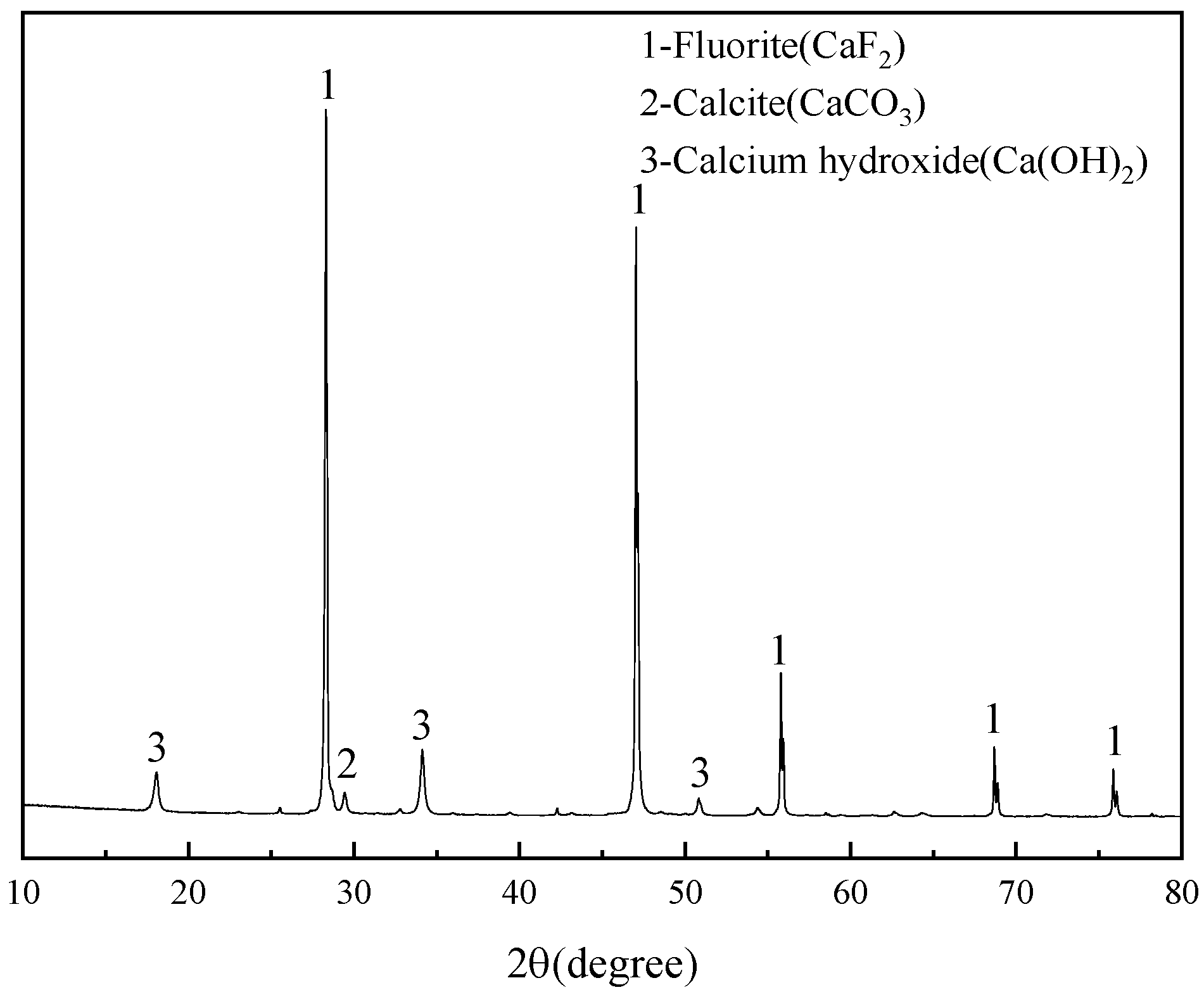
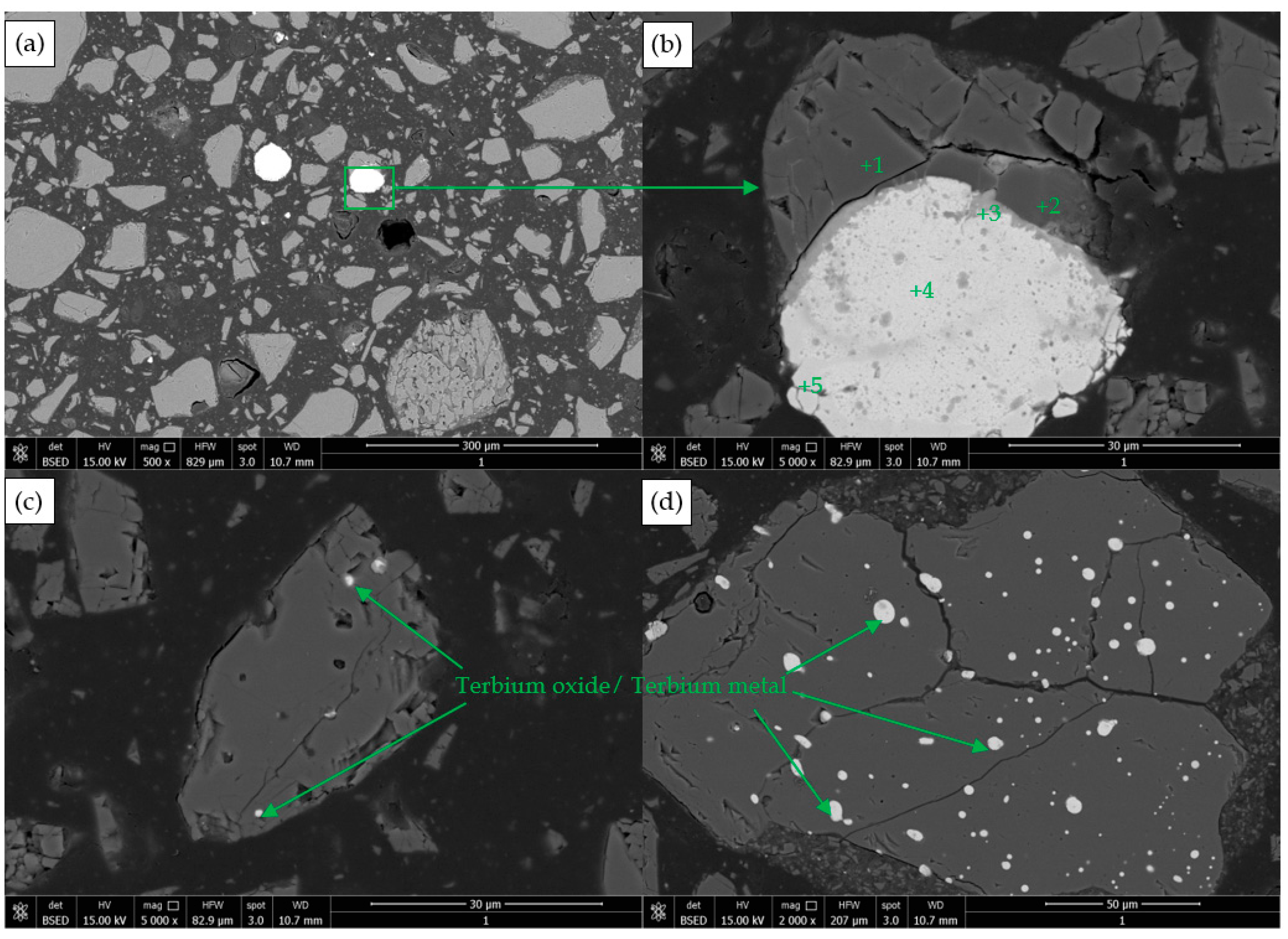
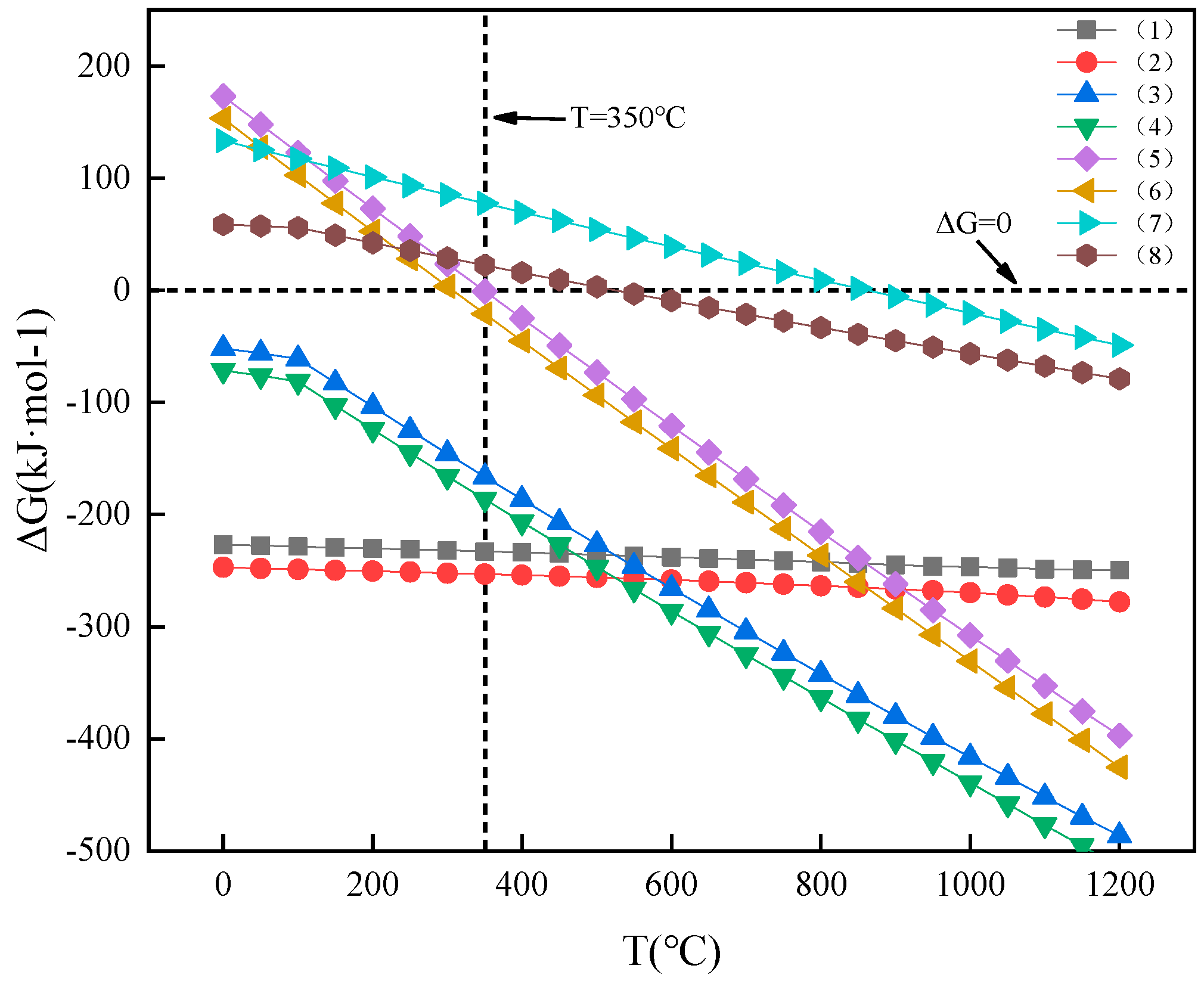
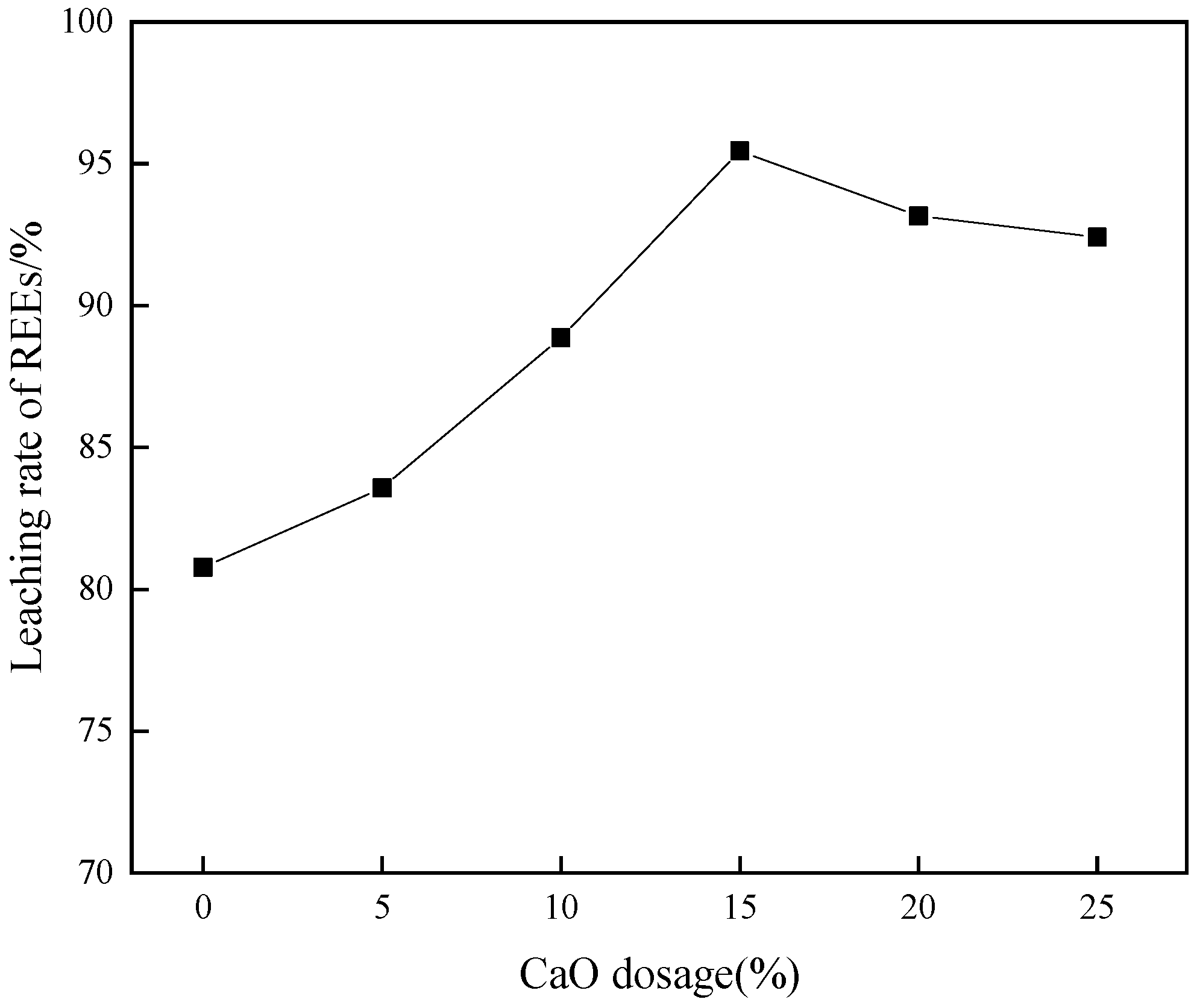

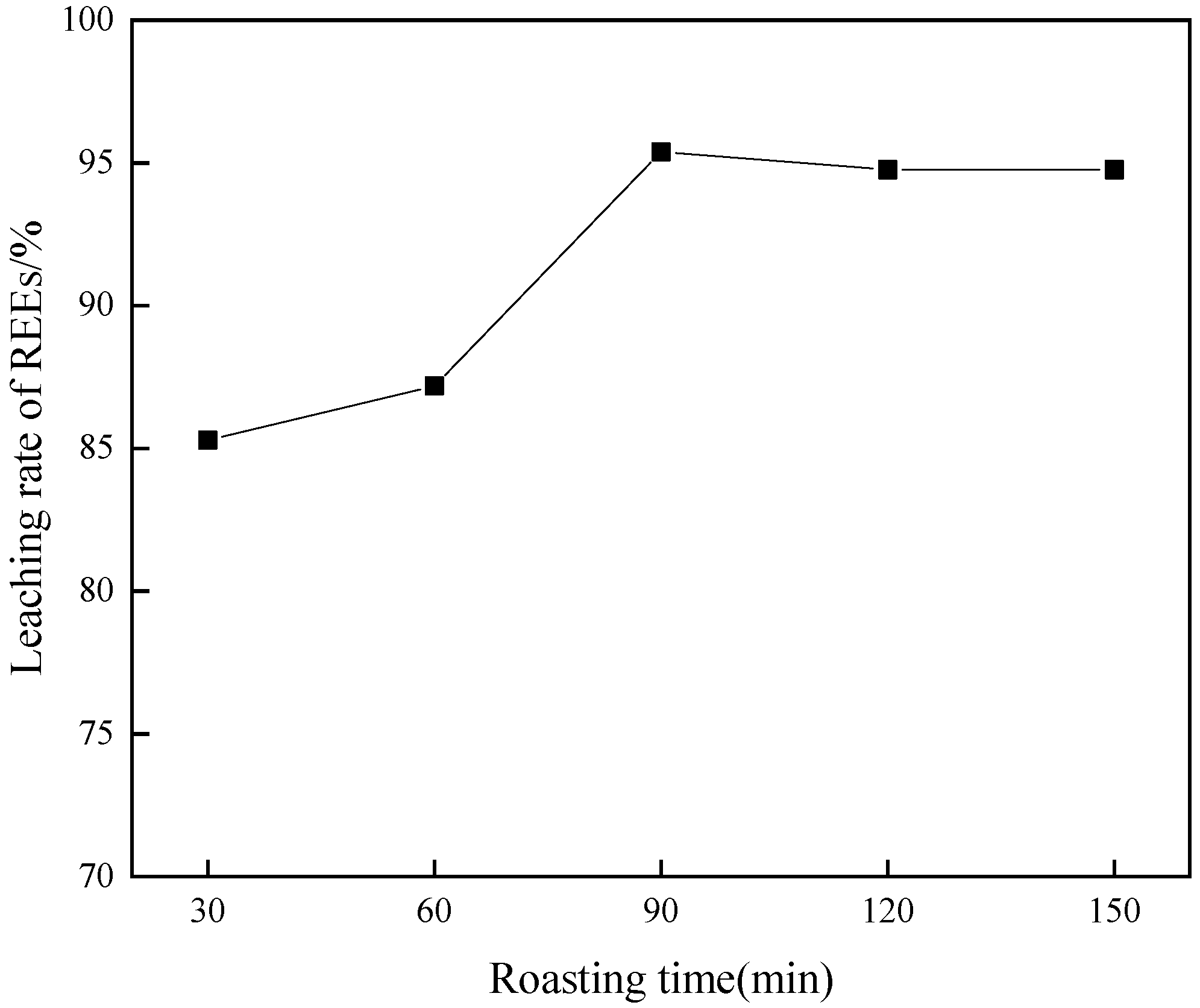


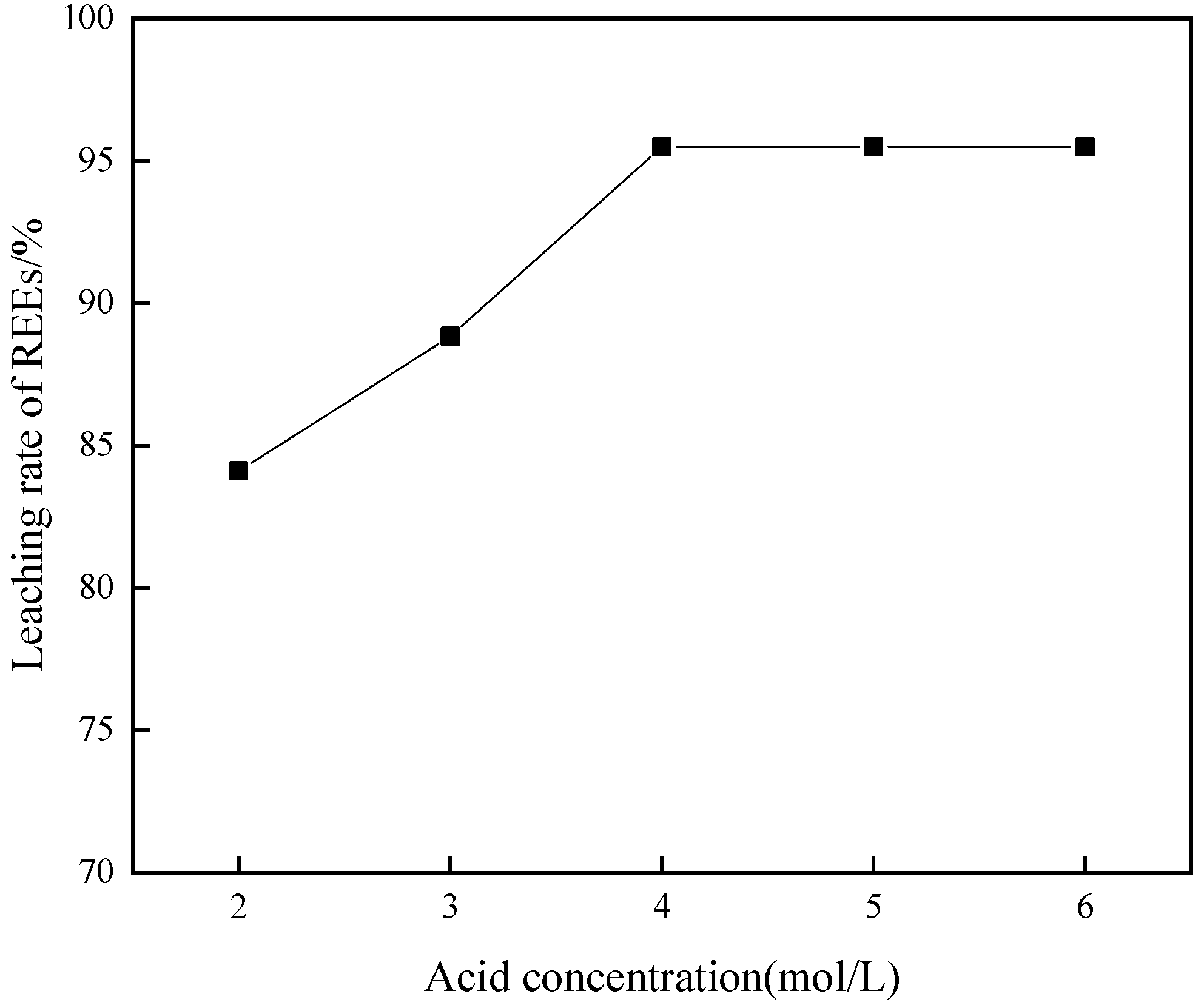
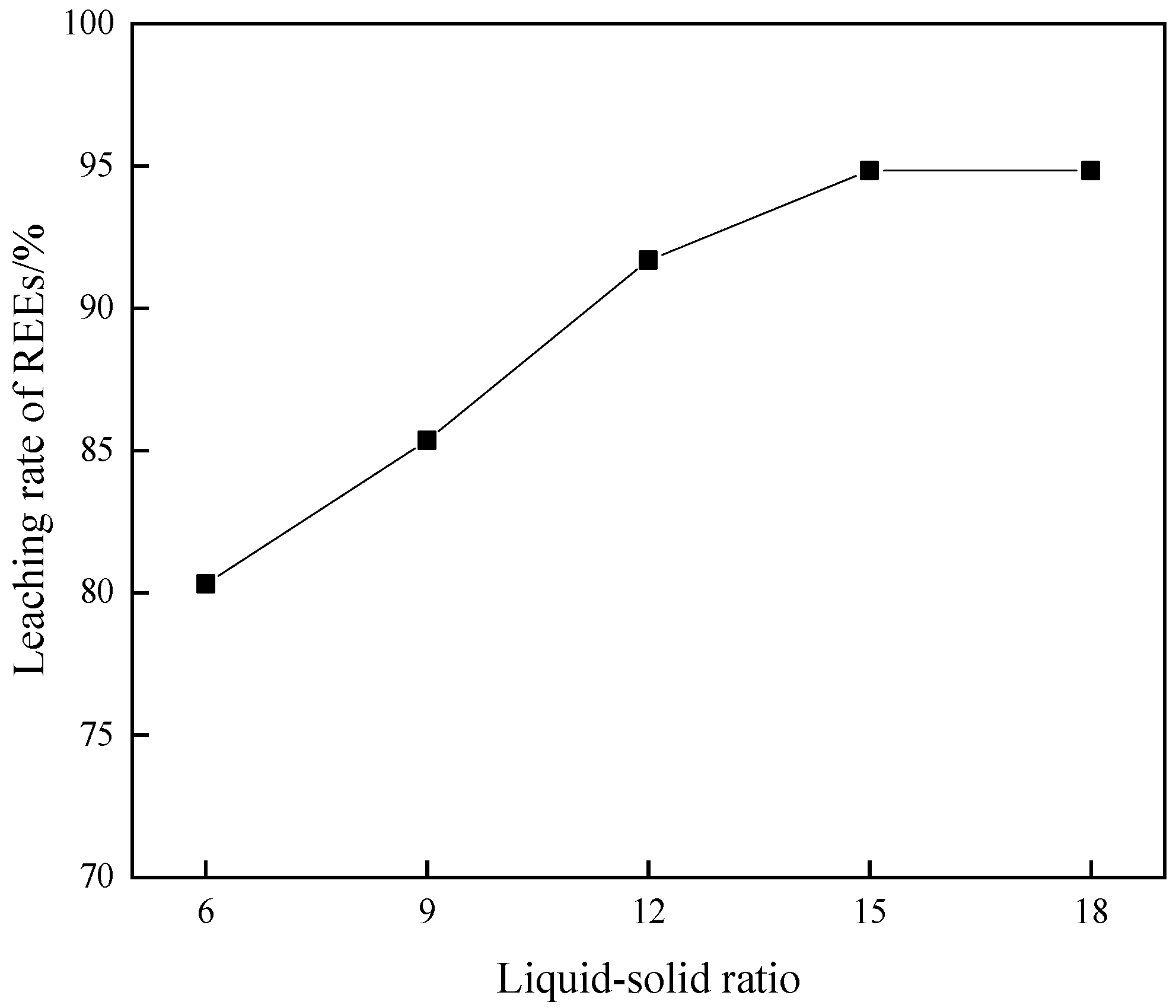
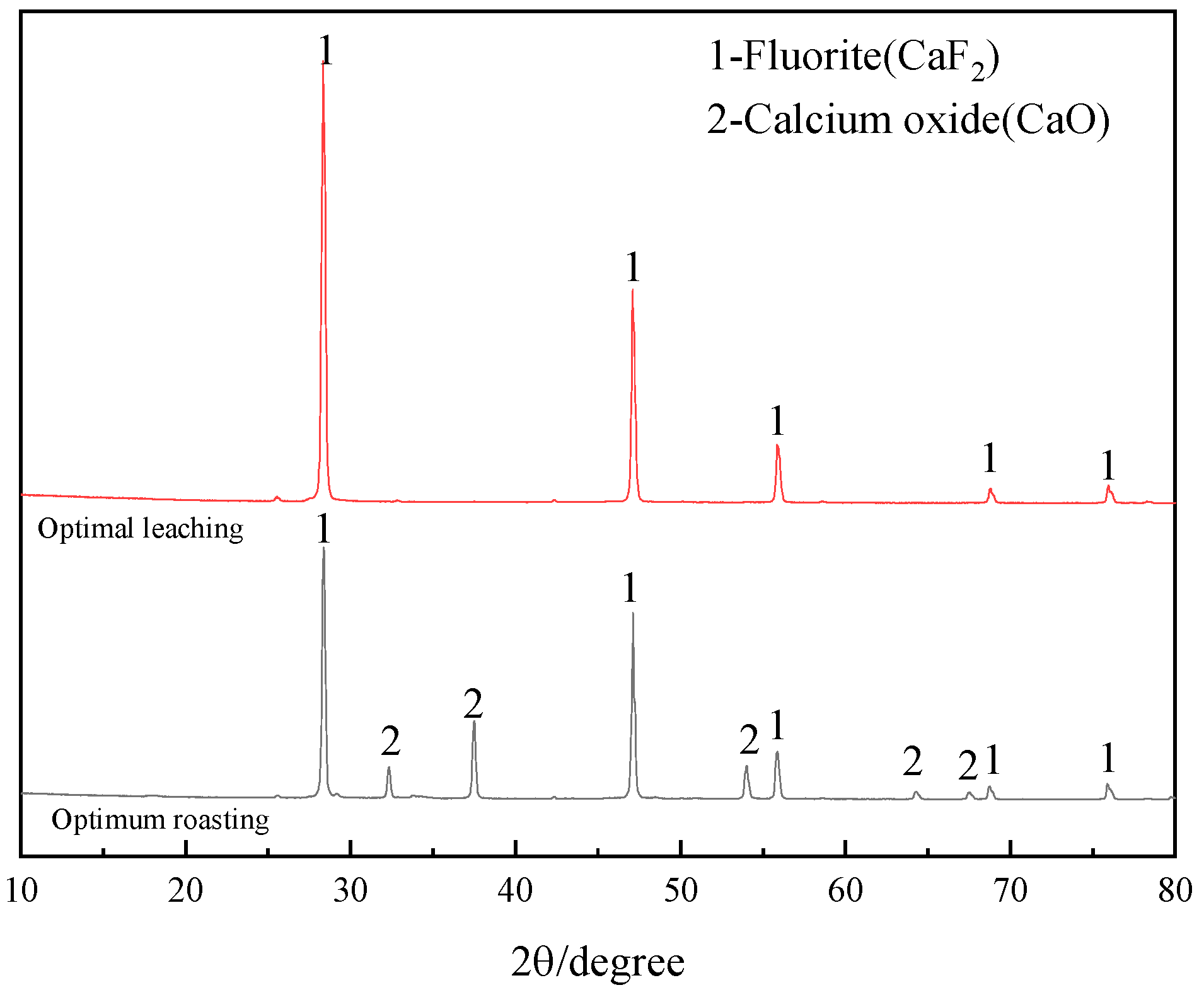




| Elements | TREO | F | Ca | Al | Fe |
|---|---|---|---|---|---|
| Assay | 2.33 | 36.74 | 51.01 | 0.085 | 0.021 |
| Elements | Tb4O7 | Nd2O3 | Y2O3 | Dy2O3 | Tm2O3 |
|---|---|---|---|---|---|
| Content | 94.20 | 2.42 | 0.70 | 0.63 | 0.42 |
| Point | O | F | Ca | Tb | Phase |
|---|---|---|---|---|---|
| 1 | - | 38.71 | 60.48 | 0.81 | Fluorite |
| 2 | - | 41.67 | 56.89 | 1.44 | Fluorite |
| 3 | 17.18 | - | 13.59 | 69.20 | Terbium oxide |
| 4 | 1.15 | - | - | 98.84 | Terbium metal |
| 5 | 0.19 | - | 1.06 | 98.74 | Terbium metal |
| Equation | Reactions | ΔG (kJ·mol−1) |
|---|---|---|
| (1) | 2TbF3 + 3CaO → Tb2O3 + 3CaF2 | −0.000002T2–0.0178T − 226.72 |
| (2) | 2NdF3 + 3CaO → Nd2O3 + 3CaF2 | −0.00001T2–0.0109T − 247.65 |
| (3) | 2TbF3 + 3Ca(OH)2 → Tb2O3 + 3CaF2 + 3H2O(g) | 0.000006T2–0.3889T − 32.731 |
| (4) | 2NdF3 + 3Ca(OH)2 → Nd2O3 + 3CaF2 + 3H2O(g) | −0.000004T2–0.3819T − 53.666 |
| (5) | 2TbF3 + 3CaCO3 → Tb2O3 + 3CaF2 + 3CO2(g) | 0.00002T2–0.5051T + 172.99 |
| (6) | 2NdF3 + 3CaCO3 → Nd2O3 + 3CaF2 + 3CO2(g) | 0.00001T2–0.4981T + 152.05 |
| (7) | CaCO3 → CaO + CO2(g) | 0.000009T2–0.1624T + 133.23 |
| (8) | Ca (OH)2 → CaO + H2O(g) | 0.000003T2–0.1237T + 64.662 |
| Point | O | F | Ca | Tb | Phase |
|---|---|---|---|---|---|
| 1 | 8.73 | 0.24 | 3.05 | 87.98 | Terbium metal |
| 2 | 13.82 | - | 4.36 | 81.82 | Terbium oxide |
| 3 | 8.82 | - | 3.69 | 87.49 | Terbium metal |
| 4 | 3.26 | 36.56 | 59.72 | 0.47 | Fluorite |
| 5 | - | 42.32 | 57.55 | 0.12 | Fluorite |
| 6 | - | 41.94 | 57.98 | 0.07 | Fluorite |
| 7 | - | 61.09 | 38.89 | 0.02 | Fluorite |
| Parameters | Values | Chemical Reaction Control | Three-Dimensional Diffusion Control | New Variant of Shrinking Core Model | |||
|---|---|---|---|---|---|---|---|
| 1 − (1 − x)1/3 = k1t | 1 − 2x/3 − (1 − x)2/3 = k2t | 1/3ln(1 − x) − 1 + (1 − x)−1/3 = k3t | |||||
| K1 | R2 | K2 | R2 | K3 | R2 | ||
| T/°C | 30 | 0.00616 | 0.97693 | 0.00195 | 0.97236 | 0.00256 | 0.90109 |
| 40 | 0.00699 | 0.94771 | 0.00243 | 0.99165 | 0.00385 | 0.93028 | |
| 50 | 0.00846 | 0.94049 | 0.00326 | 0.99887 | 0.00735 | 0.94058 | |
Disclaimer/Publisher’s Note: The statements, opinions and data contained in all publications are solely those of the individual author(s) and contributor(s) and not of MDPI and/or the editor(s). MDPI and/or the editor(s) disclaim responsibility for any injury to people or property resulting from any ideas, methods, instructions or products referred to in the content. |
© 2024 by the authors. Licensee MDPI, Basel, Switzerland. This article is an open access article distributed under the terms and conditions of the Creative Commons Attribution (CC BY) license (https://creativecommons.org/licenses/by/4.0/).
Share and Cite
Huang, J.; Zhang, L.; Yu, W.; Chen, J.; Le, C.; Ren, S. Extraction of Rare Earth and CaF2 from Rare Earth Calcium Thermal Reduction Slag by Using CaO Roasting–Acid Leaching Method. Minerals 2024, 14, 1001. https://doi.org/10.3390/min14101001
Huang J, Zhang L, Yu W, Chen J, Le C, Ren S. Extraction of Rare Earth and CaF2 from Rare Earth Calcium Thermal Reduction Slag by Using CaO Roasting–Acid Leaching Method. Minerals. 2024; 14(10):1001. https://doi.org/10.3390/min14101001
Chicago/Turabian StyleHuang, Jinqiu, Lizhi Zhang, Wen Yu, Jiangan Chen, Chengtao Le, and Sili Ren. 2024. "Extraction of Rare Earth and CaF2 from Rare Earth Calcium Thermal Reduction Slag by Using CaO Roasting–Acid Leaching Method" Minerals 14, no. 10: 1001. https://doi.org/10.3390/min14101001
APA StyleHuang, J., Zhang, L., Yu, W., Chen, J., Le, C., & Ren, S. (2024). Extraction of Rare Earth and CaF2 from Rare Earth Calcium Thermal Reduction Slag by Using CaO Roasting–Acid Leaching Method. Minerals, 14(10), 1001. https://doi.org/10.3390/min14101001








